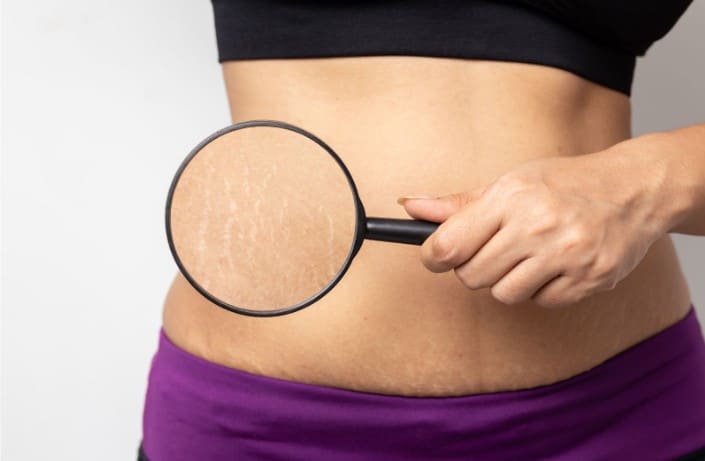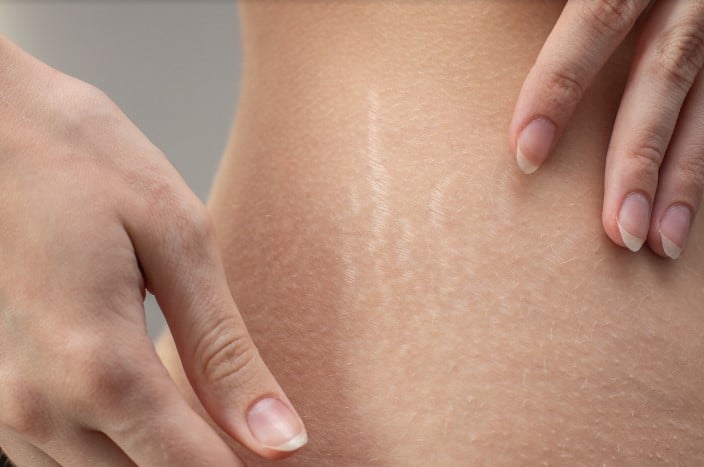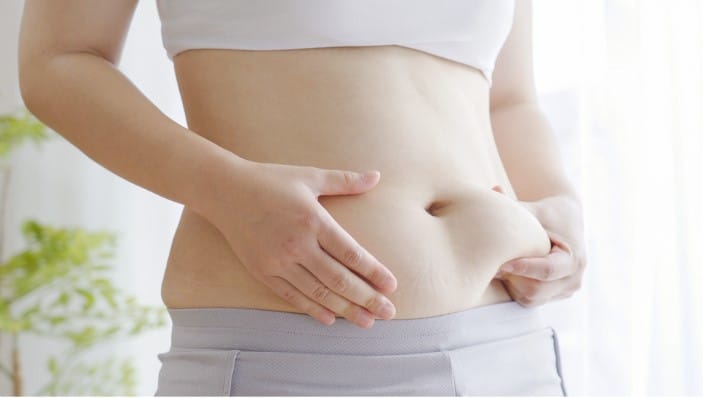
It’s hard to overstate the health benefits of weight loss, especially if the person who lost weight was obese before. While weight loss is great, one of the undesired side effects of losing weight is the appearance of stretch marks. These stretch marks often appear in our moment of triumph over excess weight and can be a psychological downer.
Which is why in this article, we take a closer look at what causes stretch marks post weight loss, whether these stretch marks will ever go away, and what can be done to them.

Stretch marks are visible stripes on the skin, commonly at spots where the dermis has been excessively stretched, in this case, due to weight gain and obesity. As you lose weight, these marks will appear often linear in nature, and run parallel to each other in the affected area.
The stretch marks that you commonly see after weight loss are known as striae distensae alba. These are white and have been on the body for a while. New stretch marks, or striae distensae rubra, tend to be reddish in colour.
While they tend to be harmless, stretch marks are an aesthetic issue that can emotionally and mentally affect individuals who have them. Stretch marks can make those affected feel uncomfortable in settings where they need to expose their bodies, for example at the gym or by the pool.
While weight loss should be celebrated, these stretch marks cause those who have been successful in their quest to remain ashamed of their bodies. These marks should not cloud the success they have already achieved, which is why treatment should be sought out as soon as possible for the best outcome.

Besides rapid weight loss, there are some unexpected situations where people stand a higher risk of developing stretch marks. For example:
Pregnancy: Rapid stretching occurs in the final trimester, as the foetus grows quickly. Similar to the rapid weight gain scenario, the growth of the foetus over-stretches the dermis, breaking skin fibres.

Stretch marks can appear on various body parts. However, there are some common areas that are more likely to stretch during rapid physical changes.
It is easy for stretch marks to appear on the breasts. The breasts tend to have significant growth and shrinkage during the process of rapid weight gain and loss, leaving stretch marks behind as a sign of the quick changes in body size. This can also happen during or after breastfeeding.
We mentioned the biceps earlier in this article. However, in the case of most people, it is weight loss that causes marks to show in this area. Flabby arms, combined with the long-term pull of gravity, can result in stretch marks. These stretch marks also become obvious after weight loss.
The thighs are another area where stretch marks tend to become visible post weight loss. The legs have large muscle groups that, when covered by fat, expand to cause stretching of the skin. It is no surprise that this results in stretch marks once all that fat is gone.
The buttocks are particularly vulnerable to stretch marks, as they grow rapidly during weight gain. While the buttocks are not exposed to the sun, having stretch marks here might put a downer on an otherwise sunny bikini beach day.
There are plenty of steps that can be taken to reduce the risk of stretch marks after weight loss, but they may only be mildly effective. For example, if you’ve just started your weight loss journey, you can try losing weight slowly to reduce the chances of stretch marks forming.
However, this step may be challenging as controlling the amount of weight to lose may not be as easy as it seems. So, the best we can do is to alleviate the severity of the condition by taking certain steps for skin wellness.
Moisturising can assist in maintaining skin elasticity. This does not guarantee that the skin will not suffer from stretch marks. However, the extra hydration is particularly important if you are undergoing rapid weight loss as the extra moisture helps to maintain the skin’s elasticity, reducing the appearance of stretch marks.
To support skin renewal and collagen production after weight loss, good nutritional intake is important. Try to include a good mix of vegetables, fruits, seafood and lean meats for nutrients like Vitamins C, D, & E, as well as protein for collagen renewal.
Insufficient Vitamin D intake can lead to an increase in estrogen receptors, which raises the likelihood of stretch marks appearing. As a result, Vitamin D intake helps to reduce the occurrence of stretch marks in your weight loss journey.
While many creams on the market claim effectiveness for stretch mark reduction, very few of them work. There is a prescription-only, medically supported cream - Tretinoin. Tretinoin is a Vitamin-A (Retinol) derivative that is known to safely and effectively treat multiple skin conditions due to its ability to increase epithelial cell turnover. When used topically, tretinoin has been found to reduce the severity of stretch mark appearance. However, it is important to note that the cream tends to be effective for early, active stretch marks. Pregnant women should avoid using this cream as it is unsafe for use during pregnancies.

What if you’ve already lost all the weight and the scars remain? The best treatment for these types of stretch marks are medical, and tend to work best when done at an early stage, just like scars. Besides the use of prescription creams, RF-based therapy, laser therapy, injectables like collagen stimulating factors or growth factors, and microdermabrasion can also be used to treat stretch marks.
This form of treatment is painless and works to reduce the appearance of white stretch marks by targeting the upper layer of the skin. By removing the dead skin on the top, new and healthier skin can form in its place. It is important to note that this treatment is limited in effect and may not be able to completely remove stretch marks.
Fractional Microneedle Radiofrequency delivers heat to a precise layer of the skin using exceptionally small needles. This heat helps to reshape scarring and improve the appearance of stretch marks. Radiofrequency (RF)-based treatments tend to be better at broad-based treatments, helping to tighten an entire area of loosening skin or working on stretch marks that are very widespread
The difference between this and a laser-based treatment is the shape of the affected area. While ablative lasers create a small, column-shaped wound that extends deeper into the skin, this form of RF treatment generates a pyramid shaped wound that has lower downtime, amongst other benefits.
There is also the option of using lasers. In this case, a fractional laser could be used to smooth out the stretch marks. These lasers are often used to treat scarring and are able to reduce the appearance of stretch marks quickly and safely. Fractional Infrared lasers are more precise than RF-based treatments, allowing us to better trace stretch marks to reduce their area and improve the colour matching with surrounding skin. Pico lasers also fall under this category.
These treatments are often used for less obvious scars, and work by targeting haemoglobin in the blood vessels to destroy them. This form of laser mostly addresses the red parts of red stretch marks, but does not affect the width, depth or thickness of the stretch marks.

There are many options to permanently remove stretch marks. To find out what is best for you based on your skin type, stretch mark type, and budget, you should undergo a detailed examination by our qualified doctor, who will then arrive at a suitable treatment option.
Feel free to consult us at 1Aesthetics Medical & Surgery for the removal of your stretch marks, we can provide you with the necessary diagnosis and treatment to alleviate the condition. Call us at 66125173, or WhatsApp us at 84899962.
Address:
1Aesthetics, Medical & Surgery
#14-90 The Central Tower 1
8 Eu Tong Sen Street
Singapore 059818
Mon-Fri 10 AM to 730 PM
Sat 10 AM to 6 PM
Phone / WhatsApp:
+65 66125173 / +65 84899962
Email:
[email protected]